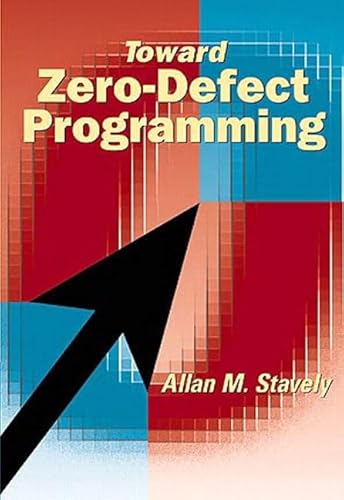Articoli correlati a Toward Zero-Defect Programming

Le informazioni nella sezione "Riassunto" possono far riferimento a edizioni diverse di questo titolo.
Allan M. Stavely was a faculty member in the Computer Science Department at New Mexico Tech for more than twenty years. He has also been a visiting staff member at IBM Research in San Jose, California; at Hewlett-Packard Labs in Bristol, England; and at IBM UK Laboratories at Hursley Park, Winchester, England. Much of his teaching, and most of his research, have focused on software engineering, formal methods, and improved methods of programming in general. Dr. Stavely is now an independent consultant, and can be reached at astavely@acm.org; he has web pages at http://www.nmt.edu/~astavely.
0201385953AB05072001
Read a paper by the author describing a course taught using this book.
Toward Zero-Defect Programming describes current methods for writing (nearly) bug-free programs. These methods are based on practices developed at IBM and elsewhere under the name Cleanroom Software Engineering. The successful application of these methods in commercial projects over the past fifteen years has produced defect rates that are, at least, an order of magnitude lower than industry averages. Remarkably, this reduction in defects comes at no net cost; on the contrary, it is often accompanied by increased productivity and shorter overall development time!
In a concise and well-illustrated presentation, Stavely shows how these methods can be applied in three key areas of software development:
- specification
- verification
- testing.
Requiring formal specifications, and requiring that the code be proved mathematically to agree with the specifications, forces software engineers to program more simply and more clearly, eliminating many defects as a consequence. Performing verification as part of a team process uncovers additional defects and encourages careful examination of the program for efficiency and other quality aspects. Testing the program, to compensate for human fallibility in the preceding steps, catches (nearly) all remaining bugs.
Highlights- Explains Cleanroom methods for developing high-quality software.
- Encourages a team process for program verification.
- Illustrates the importance of incremental development.
The author departs somewhat from IBM Cleanroom methods in simplifying the procedures that readers must learn. His aim is to make specification and verification readily accessible to any student or practitioner who can write well-structured programs. No great mathematical sophistication is assumed. Although the book’s examples are written in a number of programming languages to explain different points, the largest number are in C; therefore, a prior knowledge of C is useful.
Le informazioni nella sezione "Su questo libro" possono far riferimento a edizioni diverse di questo titolo.
- EditoreAddison-Wesley Professional
- Data di pubblicazione1998
- ISBN 10 0201385953
- ISBN 13 9780201385953
- RilegaturaCopertina flessibile
- Numero di pagine240
- Valutazione libreria
Compra nuovo
Scopri di più su questo articolo
Spese di spedizione:
EUR 3,75
In U.S.A.
I migliori risultati di ricerca su AbeBooks
Toward Zero-Defect Programming
Descrizione libro Paperback. Condizione: new. New. Fast Shipping and good customer service. Codice articolo Holz_New_0201385953
Toward Zero-Defect Programming
Descrizione libro Condizione: new. Codice articolo FrontCover0201385953
Toward Zero-Defect Programming
Descrizione libro Paperback. Condizione: new. New Copy. Customer Service Guaranteed. Codice articolo think0201385953
Toward Zero Defect Programming - Applications of Functions and Probabilities in Electronic Communications
Descrizione libro Condizione: New. Brand New Original US Edition.We Ship to PO BOX Address also. EXPEDITED shipping option also available for faster delivery.This item may ship from the US or other locations in India depending on your location and availability. Codice articolo ABTR-285516
Toward Zero-Defect Programming
Descrizione libro Paperback. Condizione: new. New. Codice articolo Wizard0201385953
Toward Zero Defect Programming - Applications of Functions and Probabilities in Electronic Communications
Descrizione libro Condizione: New. Brand New Original US Edition. Customer service! Satisfaction Guaranteed. This item may ship from the US or our Overseas warehouse depending on your location and stock availability. We Ship to PO BOX Location also. Codice articolo ABRR-285516
TOWARD ZERO-DEFECT PROGRAMMING
Descrizione libro Condizione: New. New. In shrink wrap. Looks like an interesting title! 0.92. Codice articolo Q-0201385953
Toward Zero Defect Programming
Descrizione libro Couverture rigide. Condizione: Neuf. Edition originale. Codice articolo ABE-18152832868

